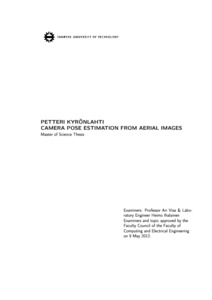Camera Pose Estimation from Aerial Images
Kyrönlahti, Petteri (2012)
Kyrönlahti, Petteri
2012
Signaalinkäsittelyn ja tietoliikennetekniikan koulutusohjelma
Automaatio-, kone- ja materiaalitekniikan tiedekunta - Faculty of Automation, Mechanical and Materials Engineering
Tieto- ja sähkötekniikan tiedekunta - Faculty of Computing and Electrical Engineering
This publication is copyrighted. You may download, display and print it for Your own personal use. Commercial use is prohibited.
Hyväksymispäivämäärä
2012-10-03
Julkaisun pysyvä osoite on
https://urn.fi/URN:NBN:fi:tty-201210051311
https://urn.fi/URN:NBN:fi:tty-201210051311
Tiivistelmä
This thesis demonstrates the applicability of the digital camera as an aerial po sitioning device. The necessary theory behind digital, optical imaging systems and geometrical image formation is presented. In addition, basic image distortions and camera calibration are introduced. However, the main emphasis is on the correspondence problem between two images and on camera pose estimation. The position and orientation of the camera can be estimated relatively to previous known coordinates or absolutely to some reference coordinate system.
In relative camera pose estimation, the correspondences between two consecutive images can be recognized from image derivatives. In general, di erential methods are used for low resolution images with high frame rates. For high resolution images, feature-based methods are generally more appropriate. Image features are often detected with subpixel accuracy, and their surroundings are described with feature vectors. These feature vectors are matched between two images to and the pointwise correspondences. The relative translation and orientation of the camera can be estimated from the correspondences. However, the major problem in all relative positioning methods is the error accumulation, where errors from previous estimations are accumulated to further estimations.
The error accumulation can be avoided by registering sensed aerial images to previously captured georeferenced images, which coordinates are known for every pixel. In this thesis, image registration between the reference image and an aerial image is implemented manually. Position and orientation of a camera are estimated absolutely to the reference coordinate system.
This thesis presents algorithms to solve the correspondence problem and to estimate the relative and absolute position and orientation of an aerial camera. The presented algorithms are verified with virtual Google Earth images and real-lif eaerial images from the test ight. In addition, the performance of the algorithms is also analyzed in terms of noise resistance.
In relative camera pose estimation, the correspondences between two consecutive images can be recognized from image derivatives. In general, di erential methods are used for low resolution images with high frame rates. For high resolution images, feature-based methods are generally more appropriate. Image features are often detected with subpixel accuracy, and their surroundings are described with feature vectors. These feature vectors are matched between two images to and the pointwise correspondences. The relative translation and orientation of the camera can be estimated from the correspondences. However, the major problem in all relative positioning methods is the error accumulation, where errors from previous estimations are accumulated to further estimations.
The error accumulation can be avoided by registering sensed aerial images to previously captured georeferenced images, which coordinates are known for every pixel. In this thesis, image registration between the reference image and an aerial image is implemented manually. Position and orientation of a camera are estimated absolutely to the reference coordinate system.
This thesis presents algorithms to solve the correspondence problem and to estimate the relative and absolute position and orientation of an aerial camera. The presented algorithms are verified with virtual Google Earth images and real-lif eaerial images from the test ight. In addition, the performance of the algorithms is also analyzed in terms of noise resistance.
